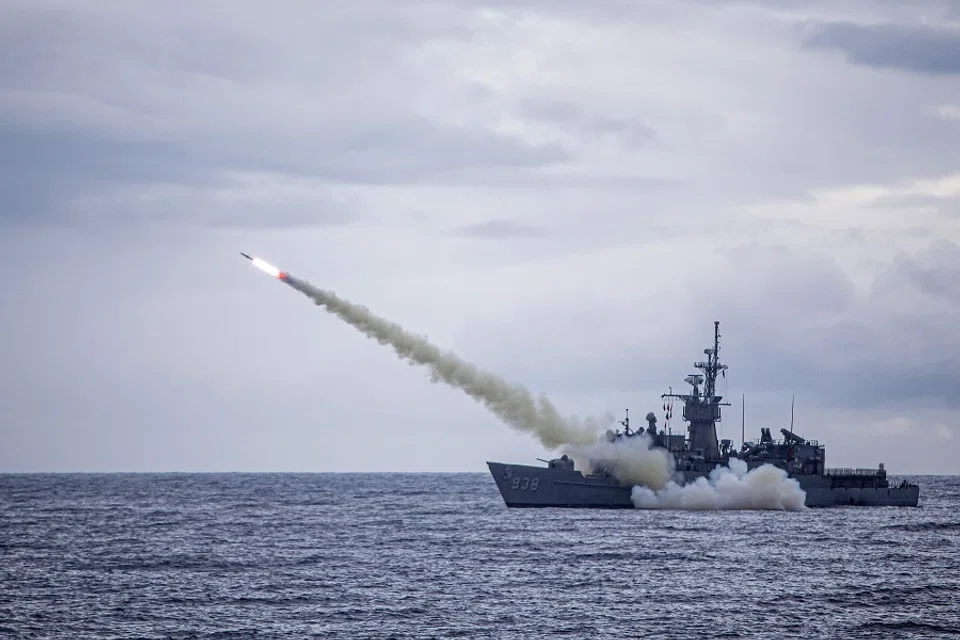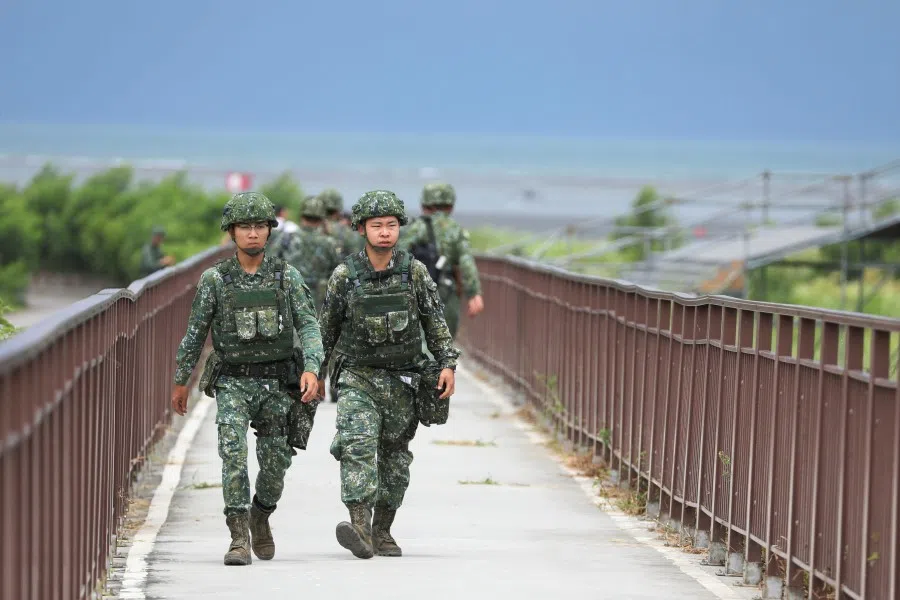The median line of the Taiwan Strait: No longer a boundary for mainland China
Both Taiwan and mainland China have indicated that they would not fire the first shot and would only do so if provoked. Yet signs are increasing that both sides could be stumbling into war. Most recently, the PLA sent its jets over the median line of the Taiwan Strait over three days. Seth Cropsey, director of the Center for American Seapower at Hudson Institute, even offered a date for mainland China to strike. Zaobao correspondent Yu Zeyuan takes a closer look at this quagmire.

China's People's Liberation Army (PLA) crossed the median line of the Taiwan Strait over three days on 16, 18 and 19 September, stirring up war clouds over the sensitive area.
Taiwan's response thus far has been cautious. Apart from issuing multiple radio warnings, it did not impose any other tougher countermeasures. (NB: Taiwan's Minister of National Defence Yen Teh-fa said in a media interview on 21 September that as a "peace loving nation", Taiwan would not provoke or escalate tensions, but is also "not afraid of war". He said Taiwan's military is well prepared to ensure the security of the Taiwan Strait.)
In fact, amid the mainland's unprecedented military actions, the Taiwan military has softened its stance. Taiwan's United Daily News reported yesterday that in a show of its peaceful intent, the Taiwan military would not fire the first shot in a skirmish between both sides of the Taiwan Strait. It has also adjusted its rhetoric from "firing the first shot" under emergency circumstances to "exercising its right to defend itself" in response to clearly hostile behaviour.
While Taiwan's cautious behaviour lowers the risk of war between both sides of the Taiwan Strait, it also means that PLA fighters and bombers crossing the median line of the Taiwan Strait will now become the norm.
Through frequent crossings of the median line at the risk of sparking war, the mainland is showing that it no longer regards the median line as a restricted zone of both parties.

Frequent crossing of the median line by the PLA symbolic
The mainland has recently changed the decades-long status quo between both sides of the Taiwan Strait. Through frequent crossings of the median line at the risk of sparking war, the mainland is showing that it no longer regards the median line as a restricted zone of both parties. Henceforth, as long as the mainland deems necessary, it can deploy military aircraft near Taiwan to deter Taiwan separatist activities and prevent Taiwan from developing official relations with countries that have diplomatic relations with the mainland.
To the mainland, the conduct of substantive official relations between the US and Taiwan is a breakthrough in advancing "Taiwan independence". The mainland will not tolerate this.
That the median line of the Taiwan Strait no longer acts as a boundary between the mainland and Taiwan is a major change in cross-strait relations. It is also the inevitable result of the warming of Taiwan's foreign relations, especially Taiwan-US relations, since the start of this year. To the mainland, the conduct of substantive official relations between the US and Taiwan is a breakthrough in advancing "Taiwan independence". The mainland will not tolerate this.

Over the past month and more, high-level officials from the US have been visiting Taiwan consecutively. In particular, US undersecretary of state Keith Krach's Taiwan visit from 17 to 19 September marks a visit by the highest-ranking official from the US Department of State to visit Taiwan since China and the US established diplomatic relations in 1979.
Unlike US Health and Human Services Secretary Alex Azar's visit to Taiwan in August, Krach's visit is clearly more political and symbolises the US's attempt in changing the long-term "one-China policy" of not engaging in political exchanges with Taiwan. Following the deterioration of China-US relations, US congressmen have even suggested that the US establish diplomatic relations with Taiwan.
While it is unlikely that the US will cut diplomatic ties with China and establish diplomatic ties with Taiwan for now, the past two years of turmoil in China-US relations suggest that China-US relations have not hit rock bottom yet and will only get worse.
There are increasing calls in China for military unification of Taiwan, but China is also not prepared for the consequences of war.
Taiwan has more to lose than gain
However, China-US confrontation leading to increased cross-strait tensions and even the prospect of war is not good for China, US, and Taiwan, and the entire Asia-Pacific region. In particular, for Taiwan, once a cross-strait war breaks out, no matter how the US supports it, its current political situation, economic level, and lifestyle will change dramatically. One might say that if Taiwan goes on the path of no return of war, it will be the biggest loser.

On 17 September, Seth Cropsey, director of the Center for American Seapower at Hudson Institute, wrote in The Hill: "America's partisan enmity has become so intense that any result in November will be contested; a country embroiled in a succession crisis is much less likely to intervene in a high-end great-power conflict. There may never be a better moment for China to strike than the week of Nov. 3."
But military action against Taiwan is clearly not on mainland China's list of options for now. Military action will mean enormous human casualties, international pressure, resource investment, and all sorts of troublesome consequences. It will also disrupt the long-term plans of China's leaders, and seriously affect China's regular economic and social order. There are increasing calls in China for military unification of Taiwan, but China is also not prepared for the consequences of war.
The fact is, China, the US, and Taiwan are all wary of the consequences of war, but no one can or wants to appear weak.
After years of Democratic Progressive Party (DPP) rule, Taiwan is increasingly "de-sinicising", and it seems unlikely to turn back. It will be difficult for both sides to find political ground like the 1992 Consensus. And while both sides drift apart, the risk of war is also building up.
If the US stops crossing the "one China" line with its high-level political interactions with Taiwan, mainland China would also not be so focused on cross-strait relations.

Mainland China has little room to compromise on the issue of "Taiwan independence" if it wants to avoid facing a domestic turmoil that would be even more devastating than military unification. The US is playing the Taiwan card to put pressure on China, but if a cross-strait war breaks out, the US would also face enormous challenges. If it does not deploy troops, Taiwan will be unified by the mainland; if it does deploy troops, it would be in a direct war with a nuclear country, and the US would not be able to control the consequences.
However, the US is a key factor in whether war can be avoided in the Taiwan Strait. If the US stops crossing the "one China" line with its high-level political interactions with Taiwan, mainland China would also not be so focused on cross-strait relations. After all, China's biggest target for this year is to build a "moderately affluent society" (小康社会).
While China and Taiwan do not want to lightly enter a war, each side is unable to consider the issue from the perspective of the other, and is consciously or unconsciously moving towards war. If this strange and dangerous situation continues to spin out of control, all parties will end up as losers.
Related: Will the US abandon Taiwan? | Chinese academic: A 'reunification by force' would be Taiwan's last | The PLA's game of deterrence in the Taiwan Strait | Taiwan would once again be abandoned amid China-US competition | Failed 'coercive diplomacy'? Beijing might harden its stance on Taiwan after Czech delegation's visit



![[Big read] Love is hard to find for millions of rural Chinese men](https://cassette.sphdigital.com.sg/image/thinkchina/16fb62fbcf055b710e38d7679f82264ad682ce8b45542008afeb14d369a94399)
![[Big read] China’s 10 trillion RMB debt clean-up falls short](https://cassette.sphdigital.com.sg/image/thinkchina/d08cfc72b13782693c25f2fcbf886fa7673723efca260881e7086211b082e66c)
